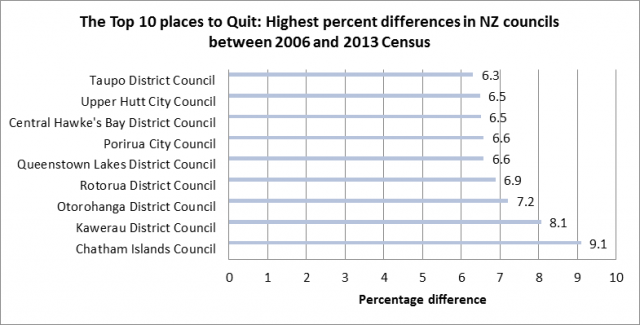In a recent blog, an .id colleague looked at smoker behaviour across Australia. The New Zealand 2013 Census results make for interesting comparison and the subject interested me after recently meeting a PhD student who was researching policy alternatives for achieving a tobacco free NZ. But I will get to that subject a bit later.

The 2013 Census found that smoking levels continue to shrink in New Zealand, decreasing from 18.9% in 2006 to 13.7% in 2013. [Note: For context the NZ census question ‘Do you smoke cigarettes regularly (that is, one or more a day)? ’ is asked of those 15 years of age. It is a cyclic question first asked in 1976 and then periodically since, hence it wasn’t asked in the 2001 census.] The 2013 NZ result is less than the 17.55% figure identified as the percentage of smokers in Australia in the 2011-12 Health Survey undertaken by the ABS.
When making comparisons between areas within New Zealand at first glance the North and South Islands claim to have very similar proportions of smokers with the North Island slightly lower at 13.69% compared to the South Island at 13.79%. However Auckland’s regionally low smoking rate of 11.64% has a huge impact on this result. A wider glance at the areas with the highest smoker percentages confirms most are in the North Island. The more rural areas of The Chatham Islands, Wairoa, Kawarau, Opotiki and Ruapehu Districts registering the highest proportions of smokers in 2013.
When comparing change between 2006 and the recent 2013 census, all areas of New Zealand registered a fall in the percentage of regular smokers – the range of that decrease in the percentage of smokers was between 9.1% and 3.5%. The following table presents the areas that have experienced the biggest percent in smoking behaviour. The Chatham Islands led the way, with their smoker percentages decreasing from 36.3% to 27.2%.

It seems like a good result on the face of it but a large number of New Zealand Health Organisations have a vision for New Zealand to be smoke free by 2025. So despite sometimes leading the world in tobacco control initiatives* The first building in the world to have a smoke-free policy was the Old Government Building in Wellington, New Zealand, in 1876, the present kiwi rate of decline will not achieve that vision and is slower than other western countries like Canada.
To get even close to a smoke free New Zealand by 2025, government would need to dramatically toughen control measures and bring in some new ones – some really innovative new ones.
The PhD student I mentioned earlier was working on alternative policy approaches and cited an innovative policy approach that has been mooted for Singapore – I think it’s interesting and, bearing in mind many readers will have a policy/social research background, worth sharing.
Rather than strengthening the current controls, the proposal looks to the future. It suggests banning the provision of tobacco to anyone born in or after a specific year – the millennium is suggested.
Essentially the idea is that the Z generation (and those born in subsequent cohorts) would never be able to legally take up the habit of smoking. They would never have the struggle of quitting because they would never start.
I am not sure if this suggestion has ever been debated in New Zealand, but it seems a policy solution worthy of consideration. It would be amazing if, as the result of policy and education, the census “smoking“ question would simply cease to be needed.
Access information on smoking behaviours for New Zealand council areas at .id’s demographic resource centre.
* New Zealand can claim the first building in the world to have a smoke-free policy. In 1876 the Old Government Building in Wellington banned smoking largely because of fire hazard concerns. New Zealand was also just the third country in the world to ban smoking in all indoor workplaces (including cafes and bars) in 2004.
Historically Captain Cook introduced tobacco to New Zealand in 1769, tobacco rose in popularity after WW2 so much so that at that time three-quarters of all adult males and one quarter of all females smoked – tobacco sales by weight peaked in 1953.











